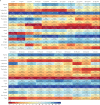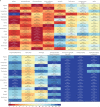Population health outcomes in Nigeria compared with other west African countries, 1998-2019: a systematic analysis for the Global Burden of Disease Study
- PMID: 35303469
- PMCID: PMC8943279
- DOI: 10.1016/S0140-6736(21)02722-7
Population health outcomes in Nigeria compared with other west African countries, 1998-2019: a systematic analysis for the Global Burden of Disease Study
Abstract
Background: Population-level health and mortality data are crucial for evidence-informed policy but scarce in Nigeria. To fill this gap, we undertook a comprehensive assessment of the burden of disease in Nigeria and compared outcomes to other west African countries.
Methods: In this systematic analysis, using data and results of the Global Burden of Diseases, Injuries, and Risk Factors Study 2019, we analysed patterns of mortality, years of life lost (YLLs), years lived with disability (YLDs), life expectancy, healthy life expectancy (HALE), and health system coverage for Nigeria and 15 other west African countries by gender in 1998 and 2019. Estimates of all-age and age-standardised disability-adjusted life-years for 369 diseases and injuries and 87 risk factors are presented for Nigeria. Health expenditure per person and gross domestic product were extracted from the World Bank repository.
Findings: Between 1998 and 2019, life expectancy and HALE increased in Nigeria by 18% to 64·3 years (95% uncertainty interval [UI] 62·2-66·6), mortality reduced for all age groups for both male and female individuals, and health expenditure per person increased from the 11th to third highest in west Africa by 2018 (US$18·6 in 2001 to $83·75 in 2018). Nonetheless, relative outcomes remained poor; Nigeria ranked sixth in west Africa for age-standardised mortality, seventh for HALE, tenth for YLLs, 12th for health system coverage, and 14th for YLDs in 2019. Malaria (5176·3 YLLs per 100 000 people, 95% UI 2464·0-9591·1) and neonatal disorders (4818·8 YLLs per 100 000, 3865·9-6064·2) were the leading causes of YLLs in Nigeria in 2019. Nigeria had the fourth-highest under-five mortality rate for male individuals (2491·8 deaths per 100 000, 95% UI 1986·1-3140·1) and female individuals (2117·7 deaths per 100 000, 1756·7-2569·1), but among the lowest mortality for men older than 55 years. There was evidence of a growing non-communicable disease burden facing older Nigerians.
Interpretation: Health outcomes remain poor in Nigeria despite higher expenditure since 2001. Better outcomes in countries with equivalent or lower health expenditure suggest health system strengthening and targeted intervention to address unsafe water sources, poor sanitation, malnutrition, and exposure to air pollution could substantially improve population health.
Funding: The Bill & Melinda Gates Foundation.
Copyright © 2022 The Author(s). Published by Elsevier Ltd. This is an Open Access article under the CC BY 4.0 license. Published by Elsevier Ltd.. All rights reserved.
Conflict of interest statement
Declaration of interests GA is a current head of the National Agency for the Control of AIDS. CI and SA held leadership roles in the Nigerian Government during the period of writing of this paper. SA is editor in chief of BMJ Global Health. IA was a scientific and technical adviser to the Nigerian Government Presidential Task Force on COVID-19 and ZI is chair of the Nigerian national ethics committee. IA, FO, GA, SA, and IMOA are members of the Presidential Health Reform Committee. All other authors declare no competing interests.
Figures






Comment on
-
Nigeria: rightly taking its place on the world stage.Lancet. 2022 Mar 19;399(10330):1093. doi: 10.1016/S0140-6736(22)00511-6. Epub 2022 Mar 15. Lancet. 2022. PMID: 35303468 No abstract available.
References
-
- UN World population prospects. 2019. https://population.un.org/wpp/
-
- World Bank Current health expenditure (% of GDP) https://data.worldbank.org/indicator/SH.XPD.CHEX.GD.ZS?end=2018&start=2000
-
- World Bank World Bank Open Data. https://data.worldbank.org/
-
- Kress DH, Su Y, Wang H. Assessment of primary health care system performance in Nigeria: using the primary health care performance indicator conceptual framework. Health Syst Ref. 2016;2:302–318. - PubMed
Publication types
MeSH terms
LinkOut - more resources
Full Text Sources
Miscellaneous

